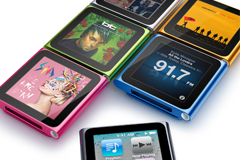
Here's the most valuable piece of advice anyone will ever give you about the new iPod nano: clip it, or lose it.
You might have seen press pictures aplenty, or even watched Steve Jobs wax lyrical about the device at the most recent Apple press conference, but nothing will prepare you for just how small the nano is.
So small, in fact, that you might initially wonder just where your money has gone.
It's a question that doesn't rest long in the mind, however. The moment you start the nano up, it's clear how far the device – now in its sixth generation – has come since its original debut five years ago.
This is very much a product of the iOS generation, and while it might not come with the operating system itself, the new 240x240 touchscreen and the software that graces its 220 pixels per inch comes with the same form, style, and usability as its larger cousins.
It could almost be used as a iOS trainer, in fact, handed out to newcomers to school them in the ways of touchscreen interfaces.
Super number sixThat's not to belittle the nano.
While it might appear to be in league with iPod touch, the reasons behind its existence are somewhat different to its iOS brethren. Despite some added bells and whistles, this is a dedicated MP3 player.
What makes this new nano a separate entity to its predecessors, however, is the obvious changes made to its interface.
Apple's largely successful attempts to make the nano a simpler, more portable experience mean the once iconic click-wheel is consigned to history, replaced with a touchscreen OS that follows many iOS principles: pinch to zoom (at least on pictures,) slide to move between the home screens (naturally only displayed four at a time), and touch and hold on icons to move them about.
Familiar to anyone with iTunes will be Apple's Genius setup, available from the home screen and enabling music of a certain style to be cobbled together in an instant, although tracks can also be listed by artist, album, genre, and composer via other icons that make up the dashboard's four pages.
The tracks themselves – which can also be coordinated to neatly fade into one another – play as any iOS user will be accustomed to, albeit in a scaled down form.
Artwork serves as a wallpaper, while your options are also split into two separate screens. A slide from the initial play screen to the repeat and randomise options is no great stretch whether static or on the go.
Simply holding your finger down on the centre of the screen brings the home screen back up whatever program you're running, which enables Apple to keep any physical buttons to a minimum.
Just three feature neatly along the top of the nano – handy volume controls and the power button so styled that you almost don't notice them.
If looks could thrillThe nano won't disgrace you in public when it comes to looks, the sheer small scale and simplicity of the device only adding to the intrigue that surrounds it.
Physically, it's entirely practical, with its generous clip meaning it can hang onto almost anything. Given that the view can be rotated with two fingers, angles aren't a problem either.
The fact that the nano is likely to be used on the go no doubt motivates two other additions – a handy FM radio, and a simple pedometer app that, as before, can be linked up to a dedicated Nike website to track you and your friends' progress.
The radio is equally impressive, with the app able to scan for all stations in range, listing them in a guide.
Most interesting, however, is the tagging feature. When supported, it's possible to tag tracks and save them to memory, with iTunes pulling them up for purchase when the next time the device is synced.
That said, whether this feature is supported worldwide is a mystery, with my run-through encountering no tag-equipped track popping up on any stations around Manchester.
Either way, there's plenty of opportunity to find out, with a fully charged nano lasting ten hours with ease (a full 24 hours attainable according to Apple's official stats) despite some fairly extensive usage.
Its streamlined approach - with apps naturally taking a back seat thanks to no App Store and, more importantly, no wi-fi – pays off here, and it's not hard to imagine existing iPod touch or iPhone users to picking up a nano on the side for truly portable play.
Indeed, all such iOS devices feel like veritable desktop PCs in comparison, both in terms of what's they're capable of and, more importantly, their size.
Anyone expecting anywhere near that kind of performance on iPod nano will likely feel duped, with the removal of video playback - no doubt due to the device's smaller screen - proving that a media hub this is not.
For what it does represent, however, it's very hard to find fault. Compact, usable and just a little bit gorgeous, the sixth generation iPod nano may be small in stature, but it plays big when it comes to practicality.
6th generation iPod nano

